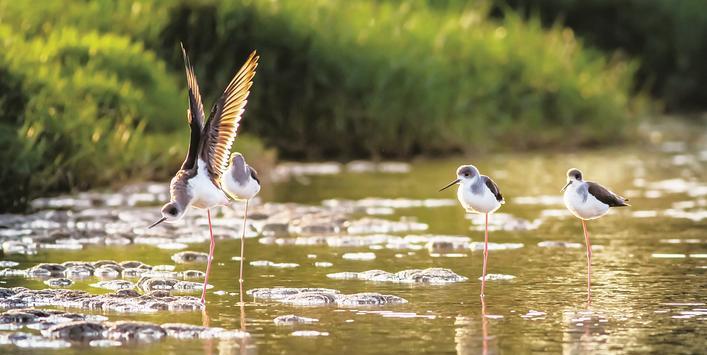
Rest your feet and take a photo by Dai Yuansheng
Playing Dai Yuansheng photo
Flying Dance Dai Yuansheng Photo
Foraging Dai Yuansheng photo
Circling Dai Yuansheng photographed
Perched by Liu Liangzhen
Recently, the weather has become cooler, and the mangroves at the mouth of the Zhangjiang River have ushered in a large number of migratory birds that have wintered south, becoming a veritable "bird paradise". Yesterday, the author stood on the bird watching platform of the Zhangjiangkou Mangrove Forest Reserve and looked out, at the intersection of blue sky and clear water, a large piece of vibrant green, partridge gathered, gulls and herons flew together.
Wu Qiucheng, a bird monitor in the reserve, said that since August every year, a large number of winter migratory birds such as plovers, geese and ducks, gulls and herons have come here to overwinter and inhabit or take a short pause, the migration route is mainly East Asia - Australia, in Russia, Japan, the Korean Peninsula and China's northeast and eastern China breeding wetland waterbirds fly all the way south to the mangroves, reaching a peak around December, when a wave of "bird waves" began to hover above the mangroves, they take off and land in an orderly and rhythmic manner, such as the sunset canopy, And if the waves come. It wasn't until April of the following year, when the weather warmed up, that these water birds from afar left one after another.
The originally quiet mangrove forest is now lively, on the surface of the sea outside, thousands of wild ducks lined up in a long line of "black line", there are long-distance migrating green-winged ducks, red-necked ducks, spoonbills, pintail ducks, as well as local spotted ducks, etc., they roost and forage in the warm sun, enjoy themselves; on the mangrove shoals, egrets, red-billed gulls, anti-billed sandpipers, black-winged long-legged sandpipers, ring-necked sandpipers, golden-eyed birds and dozens of other water birds "rest their feet" here, sometimes leisurely strolling, sometimes diving into the water from the air to fish, Sometimes flocks of herons fly in the blue sky; on the branches of the mangrove forest, herons, egrets, pond herons and other heron-like water birds stand densely on the lush canopy, like clouds like snow, and from time to time you can see thousands of heron birds flying in unison, circling and flying in the air, and the calls rise and fall, the scene is extremely spectacular... There are also some heron birds that like the environment of the mangrove forest at the mouth of the Zhangjiang River and become the "permanent residents" here.
The "bird waves" that cover the sky and the sun are sometimes scattered and sometimes gathered, adding a different dynamic beauty to the mangrove reserve, and attracting many photography enthusiasts to chase the camera excitedly, they set up "long guns and short cannons", quietly waiting in the forest, clearly capturing the birds' every move into the camera, and even see the spots on the birds' feathers and the color of the eye sockets. "Bird shooting pays attention to a 'fate' word, sometimes it will be impossible to find, sometimes it can be unexpectedly encountered, listening to the harmony of birds singing in unison in the blue waves of mangrove trees, laughing at the light and shadow of hundreds of birds in the clouds, is a great pleasure for us to shoot birds." Photography enthusiast Dai Yuansheng said. On the way to "chasing birds", he deeply felt that the ecological environment of the mangroves at the mouth of the Zhangjiang River had become better, and more birds came here to spend the winter and settle down, and more people came to know and protect birds.
In the Zhangjiangkou Mangrove Forest Reserve, many rare birds have also been recorded, such as the black-faced spoonbill and black-billed gull, the national second-level key protected wild animals black-winged kite, common eagle, black kite, red falcon, peregrine falcon, white-bellied harrier, brown-winged crow, white spoonbill, large-billed sandpiper, white-waisted sandpiper, broad-billed sandpiper, large-billed sandpiper, large-breasted sandpiper and more than ten species. Rare animals frequently appear in mangroves, which is the result of the continuous ecological restoration, strengthening resource monitoring and strengthening resource protection in the reserve.
In recent years, the Zhangjiangkou Mangrove Forest Reserve Management Bureau has continuously increased the protection of birds, continuously improved the bird habitat, mainly based on ecological natural restoration, supplemented by moderate artificial intervention, comprehensively considering various environmental factors, creating a heron breeding area, and creating a high-tide habitat that can meet the individual needs of a variety of migratory birds. Not only that, during the migratory bird migration season, the Protected Area Administration also arranges "escorts" to further integrate the joint defense team, strengthen the patrol force, and ensure that the migratory birds from afar have a safe and comfortable habitat. "Once, during the patrol, we found an injured pond heron, immediately took emergency rescue measures, sent to the wildlife rescue station in time for treatment, and waited until the bird was fully recovered and released, so that it could return to the original 'big family'." Zhang Zhang, chief of the resource protection section of the reserve, recalled the experience of rescuing pond herons and still felt very warm.
⊙ Zhu Qiaotao